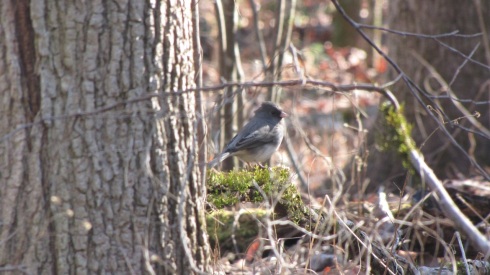Great Smoky Mountains National Park was my hiking destination yesterday. Leaving Asheville at 9 a.m., I traveled to Gatlinburg for a meeting with Todd Witcher, executive director for Discover Life in America, a non-profit organization that manages a thorough scientific inventory of all the park’s species that has been going on for the past 15 years.
After talking with Todd about the project and viewing the park’s LEED Certified Twin Creeks Science and Education Center with its vast collections room, I was excited to get out into the woods and see if I could spot some live specimens. I didn’t have a great deal of time, and so chose a short, easy trail that begins behind the Sugarlands Visitor’s Center. It was 64 degrees and about 1 p.m. when I started out on the Fighting Creek Nature Trail.
I hadn’t been hiking long when I heard quite a ruckus of high-pitched vocalizations just a “tad” off the trail. Following what I at first mistook for bird chatter, I spied a small green pond, tucked behind a grove of trees. Immediately upon seeing the water, I realized the source of the raucous sounds.
 Upon my arrival at the tiny pond’s bank, all was quiet; only the final plops of retreat echoed across the surface, now muddy from what was sure to be dozens of diving frogs!
Upon my arrival at the tiny pond’s bank, all was quiet; only the final plops of retreat echoed across the surface, now muddy from what was sure to be dozens of diving frogs!
How long does one have to sit beside a pond before the frogs will start peeping again? I decided to attempt to find out. I sat very still in the soft leaves, watching and listening. Finally, after some 20 minutes, I began to see slow movement in the water, and tiny heads with great bulging eyes began to emerge one by one all over the pond. Before long I realized I could see at least 15 pairs of eyes, all fixed on me!
Once when I lifted my binoculars to get a better view, the gleaming amphibians darted down in retreat once again. But this time, it didn’t take long for them to come back up. They seemed as interested in studying me as I was in watching them.
I adapted to making much slower movements, and they adapted to my presence. Finally, after nearly an hour, they relaxed and stopped staring at me, drifting lazily with out-splayed legs in what I suppose is their usual fashion when unmonitored. Then, with them facing away from me, I was able to get a few zoomed photographs without causing a stir. But, alas, their peeping never did resume during my surveillance.
What I did was not unlike the way that scientists involved with Discover Life in America’s All Taxa Biodiversity Inventory work to identify and record the locations of various species throughout the park. The people who combine efforts on this project are not just scientists with university degrees but also everyday armchair naturalist types who are, like me, just really interested in nature. They are what DLIA proudly calls “citizen scientists” – and without them the ATBI would not have exceeded all expectations and discovered more than 900 species in the park that are new to science!
 The nature trail loop was pleasurable and felt fairly “out there” for being so close to the visitor’s center and a major park thoroughfare, although I’m sure during warmer months there is little solitude here. There was plenty of picturesque intersection with the beautiful creek and signage pointed out a few tree species’ names that were new to me, including Hop-Hornbeam, used by the Cherokee as a painkiller. I was happy to encounter a pair of Dark-eyed Juncos – to balance the taxonomic specimens I had seen earlier. For those interested in historic structures, the restored 1860s John Ownby Cabin stands at about the half-way point. Had I not practiced patience at the peeper pond, I’d have completed the entire hike in under an hour.
The nature trail loop was pleasurable and felt fairly “out there” for being so close to the visitor’s center and a major park thoroughfare, although I’m sure during warmer months there is little solitude here. There was plenty of picturesque intersection with the beautiful creek and signage pointed out a few tree species’ names that were new to me, including Hop-Hornbeam, used by the Cherokee as a painkiller. I was happy to encounter a pair of Dark-eyed Juncos – to balance the taxonomic specimens I had seen earlier. For those interested in historic structures, the restored 1860s John Ownby Cabin stands at about the half-way point. Had I not practiced patience at the peeper pond, I’d have completed the entire hike in under an hour.
After capping off my solo adventure with a quick jaunt up to Cataract Falls (off the nature trail), I rejoined the Fighting Creek loop that led me back near the frogs’ habitat. I could hear their cacophonous chorus loud and clear, and was tempted to return to their secluded domicile for more amphibious fun.
But the sun was getting low in the sky and I had several hours’ drive ahead. It was time to set a course for my own old Kentucky home, where late last night I learned from Wikipedia that in Cherokee lore, the Sugarlands was part of the area known as “Walasi’yi,” or “Frog place.”
Learn more about Discover Life in America and the All Taxa Biodiversity Inventory.
Distance traveled: 1.6 miles
Difficulty: Easy
Birds spotted: Dark-eyed Junko, Northern Cardinal, Tufted Titmouse
Flora of note: Hop-hornbeam, Box Elder, Sycamore, Yellow Poplar, Paw Paw, Sweet Gum, Sassafras, Moosewood














Recent Comments